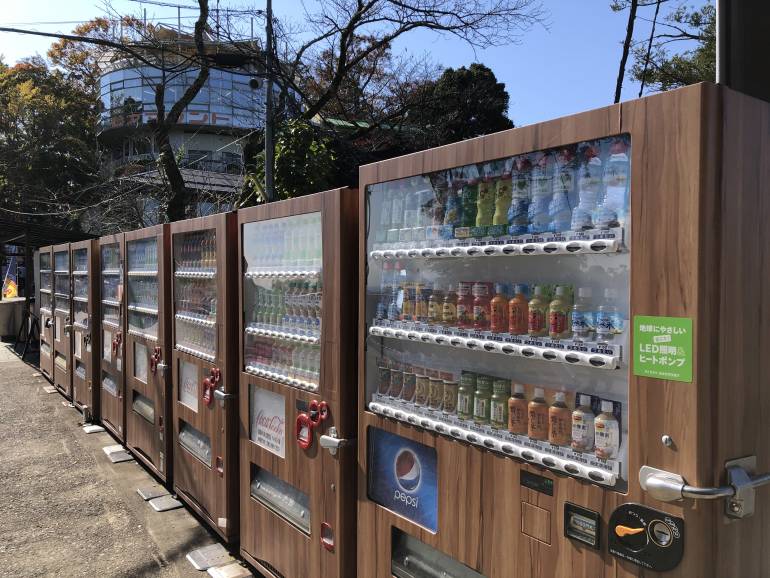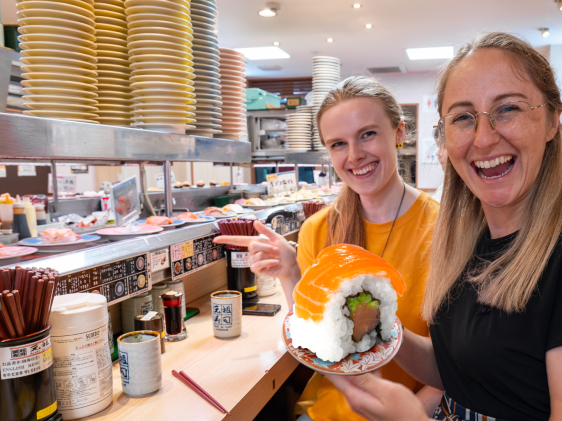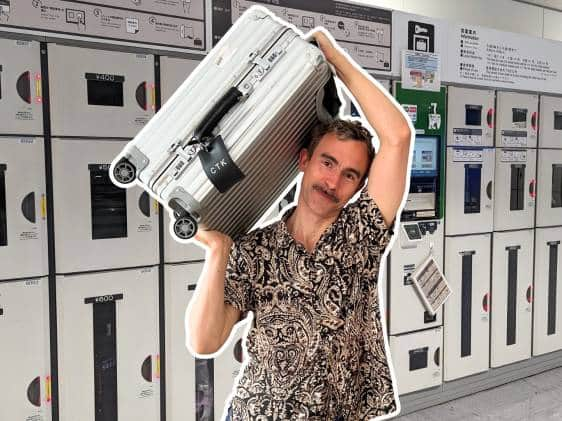Mount Takao has it all: stunning views, delicious food, and exciting festivals. Why not spend a day exploring the (semi) wilds of one of Tokyo’s best-loved mountains?
The 599m-tall mountain — called Takao-san by locals — is easily hikeable and is especially popular with couples, families, and seniors. Though you can actually skip the hiking if you like: Mount Takao has a ropeway that takes you most of the way up. It’s located in Tama at the western edge of Tokyo, about an hour by train from Shinjuku Station.
Mount Takao has been a sacred site for over 1,000 years and mountain ascetics called yamabushi would train here, in practices such as waterfall asceticism and sutra reading. Though these days far and away most visitors are just here for a nice day out. There are sights at the base and along the way to the summit, including a Buddhist temple, as well as views of Tokyo to admire.
Getting from Tokyo to Mount Takao

The nearest train station is Takaosanguchi on the Keio Line, easily accessed from Shinjuku in just under an hour. If you catch the Keiō Line Semi-Special Express for Takaosanguchi from Shinjuku, you can continue straight through without changing at Kitano. This route costs just ¥430 each way, as does the route where you change at Kitano (so don’t worry too much if you don’t get the direct one).
Takao Station, one stop before Takaosanguchi Station, is useful if you need to connect from the JR Chūō Line or the Narita Express to the Keiō-Takao Line.
When you exit Takaosanguchi Station, turn right and follow the path for 500 meters to the cable car and chairlift stations, and then keep right for the main trail up the mountain.
Top tip: Here’s where you can find hiking gear in Tokyo.
Hiking Mount Takao

One nice thing about Mount Takao is that there are several trails, with a good mix of easy and moderate, none of which take more than two to three hours.
Most people opt for Trail 1 (the Omotesando Trail). It is mostly paved and has sightseeing spots along the way, including the mountain’s temple, Yakuō-in. It can get busy though, so be prepared for a less-than-serene mountain experience. This route is the longest, at 3.8 km, and is easy-to-medium in terms of difficulty.
Important: Though Mt. Takao is seen as a fairly easy mountain to climb, it’s still a mountain, so make sure you have the right clothing (layers) and sufficient water and snacks for your trek.

Alternatively, you could opt for one (or a combination) of the other hiking trails, which are unpaved and a tad more challenging, with significantly fewer people. These include:
- Trail 2 (Kasumidai Loop): This is the easiest and shortest trail, only a 0.9 km stroll through forests, that you can pick up just past the upper stations for the cable car and chairlift.
- Trail 3 (Katsura Woods Trail): A medium trail with a focus on nature, 2.4 km of streams, forests, and views; pick it up from the summit loop or halfway along Trail 1.
- Trail 4 (Suspension Bridge Trail): A 1.5 km medium route through forests and crossing the Miyamabashi Bridge. Features lots of stairs! Pick it up from the summit loop or halfway along Trail 1.
- Trail 5 (Summit Loop Trail): An easy route of 0.9 km that loops around the summit.
- Trail 6 (Biwa Waterfall Trail): The second longest at 3.3 km — running from the base to the summit loop — and the most challenging. The trail passes a waterfall and there’s pleasantly cool forest air.
- Inariyama Trail: A 3.2 km challenging trail via Mt Inari, this is known as the every-season trail as it always has flowers or leaves to admire. Base to summit.
Trail 1 and the Inariyama Trail go all the way from base to summit, while Trail 6 goes up almost all the way, meeting Trail 5, the summit loop trail, for a nice combined route. Alternatively, hikers can mix and match, for example, following Trail 1 to the Kasumida Loop (Trail 2), for the monkey park and wild plant garden, before switching to the Suspension Bridge Trail (Trail 4), which meets up with the Summit Loop Trail (Trail 5). It can also be nice to hike up one Trail 1 to see the sights and then go down a different trail.
Pro tip: If you’d prefer to experience the mountain with a professional guide, Mount Takao day tours can be booked online. You’ll get to hear stories of the mountain’s lore and explanations about any wildlife you might encounter.
Toilets, Trash, and Vending Machines

There are vending machines and cafes at the observation deck midway up Trail 1 (just past the upper stations for the cable car and chairlift) and at the summit, but carry some supplies just in case. Also, note that the vending machines on Mt. Takao are almost twice as expensive as those on the ground! #cheapofail
Note that there are NO TRASH CANS ON MT. TAKAO, so any and all rubbish will need to be carted down the mountain with you. Bring a plastic bag or two, to be prepared.
In terms of public toilets, you’ll find them at Takaosanguchi Station, as well as around the midway observation deck and at the summit.
Hiking beyond Mount Takao
If you want to continue hiking, from the summit you can take the Takaosan-Jimbasan trail to a further observation deck called Itchōdaira. In spring, this area is filled with cherry blossom and is a popular picnic spot, but it is quieter during the rest of the year. The trail continues to Mount Kobotoke-Shiroyama, and you can explore mountains beyond; just remember not to get lost!
Want more mountains? See our comprehensive guide to hiking trails near Tokyo for all skill levels.
Taking the cable car or chairlift

Not everyone wants to hike, but fortunately, Takao has some great options to get you up to the views without breaking a sweat.
You can catch either the chairlift or cable car part-way up (or down) Takao’s Trail 1. This takes you close to the Kasumidai Observation Deck and the monkey park. From here, it is around 15 minutes to the temple and 40 minutes to the summit. The lower cable car and chair lift stations are at the start of Trail 1. There are lockers on both ends, should you want to stash your bags.
Pro tip: If you’re planning on taking the cable car or chair lift and will be traveling to and from Mount Takao on the Keio line, this special 1-Day Takao ticket is good value. ¥1,690 gets you:
- 1-day Keio line and Inokashira Line ticket
- Round-trip cable car and chair lift ticket
- Admission to the Mt. Takao Monkey Park & Wild Plant Garden

The cable car takes 6 minutes and runs every 15 minutes between 8 a.m. and 5 or 6 p.m. depending on the season. It runs until 9:15 p.m. when the beer garden is open. Rides on the covered twin-seater chairlift take 12 minutes and run from 9 a.m. to 4 p.m. (or 4:30 p.m. depending on the season). Both cost ¥490 one-way for adults and ¥250 for children.
You can pick up a return ticket for ¥950, saving you a cool ¥30 (we never said Japan was good at deals).
Top attractions on or around Mount Takao
While nature is all well and good, Mount Takao has some bonuses that make hiking it all the more rewarding. These are what make it especially popular for families or as a date destination.

Mount Fuji views (summit)
On a clear day you can see Mount Fuji from the summit, so keep your fingers and toes crossed!
If you climb around the winter solstice in December, you might also be able to catch a rare occurrence known as Diamond Fuji, when the sun sets directly atop Fuji-san, creating a perfect diamond. However, you’ll need to make sure you are off the mountain well before darkness falls.
Yakuō-in Temple (Trail 1)

Yakuō-in is an impressive temple close to the summit of Mount Takao and has been protected for centuries. The brightly colored decorative carvings are a thing of wonder, and exploring the temple grounds is especially beautiful in autumn as the leaves change.
Founded in 744 by Gyōki Bosatsu, the temple has a monument inscribed with sessho kindan, meaning that killing is prohibited and reflects the strict protective laws which have existed since its foundation.
Most well-known, however, are the tengu statues which guard the temple complex. Mythical beings who act as messengers of deities, tengu live on sacred mountains and chastise evil people while protecting the good. At Yakuō-in, there are two types depicted in statues and images throughout the grounds: one with a long pointed nose and one with a crow’s beak.
The temple is free to enter and is reached via Trail 1. It is about 10–20 minutes from the summit if you are hiking down, and the same distance from the ropeway stop.
Mt Takao Monkey Park and Wild Plant Garden (Trail 1)

Nature lovers are spoiled for choice on Mount Takao. Not only are there stunning natural landscapes and the forests of the mountain itself, but there are also areas dedicated to wild grasses and monkeys.
In the Monkey Park, 60 monkeys are living in a natural habitat, with guides famed for great storytelling skills. Some monkeys answer to their names and can be seen up close. The Wild Plant Garden has over 300 species of native grasses which once prospered on the mountain but were almost lost following development.
A single ticket (¥500) gets you into both attractions, which are usually both open from 9.30 a.m. to 4:30 p.m., depending on the season.
Takao 599 Museum (Base)

You can learn about Mount Takao before you even step foot on it, as the Takao 599 Museum offers insights into what makes the mountain so special. Visitors can find out all about the natural resources and living inhabitants of the mountain, as well as see examples of the plants and animals themselves. There is a cafe, a rest area, and also plenty of information about the hiking trails and seasonal attractions along the routes.
The museum is located close to Takaosanguchi Station, is free to enter, and is open throughout the year (with irregular closing days). Hours are between 8 a.m. and 5 p.m. (April through November) and 8 a.m. to 4 p.m. (December through March).
Takaosan Onsen Gokurakuyu (Base)

Located right next to the train station (just turn right as you come out of the ticket gates) is Takaosan Onsen Gokurakuyu. This natural hot spring is the perfect place to soak after a day of hiking (difficult or not). It offers outdoor baths where you can enjoy the atmosphere of the mountain and indoor options, too. These include a cypress bath with micro-bubbles, a seasonal bath that changes throughout the year, as well as a sauna and an outdoor carbonated option.
The onsen is open from 8 a.m. to 10:45 p.m., with the last entry at 10 p.m. Adult entrance is ¥1,100 on weekdays, while children get in for ¥550. On the weekends, holidays, and during peak season (Golden Week, autumn leaf season, and New Year), entry is ¥1,300 for adults and ¥650 for children. No tattoos allowed.
What to eat on Mount Takao

Mount Takao really does have it all, including its own food specialty — tororo soba. This is a simple dish of soba noodles in broth, usually served cold, and topped with tororo (grated yam). It’s long been believed that tororo was strength-building and thus it was served to pilgrims as they ascended the mountain. Indeed it is light, delicious, and perfect for a restorative lunch as part of a pleasant hike.
There are plenty of restaurants serving soba at the foot of the mountain, as well as along Trail 1, so you won’t struggle to find a lunch spot. One famous restaurant is Takahashiya, which has been serving the dish for 170 years and has a 150-year-old persimmon tree inside the building. It’s located across from the cable car station at the base of the mountain.

Other food options include pizza, hot dogs, and ramen, as well as coffee and sweets, mostly located around the cable car stations at the base and around the observation deck midway up Trail 1.
Alternatively, if you’re keen to sample the Buddhist life, you can try shōjin ryōri — traditional vegetarian Buddhist cuisine — at the temple, Yakuō-in. Reservations are required, and unfortunately can only be made in Japanese, but this is well worth the effort if you can manage it.
Top festivals on Mount Takao

Since the mountain has been a sacred site for over 1000 years, it is no surprise that there are plenty of festivals held here throughout the year. While the mountain is great on a regular day, these events can add a whole new dimension (but also a whole lot of people, so keep that in mind if you prefer peace and quiet).
- Geikōsai New Years Festival: This ceremony takes place at sunrise on January 1, with the priests chanting sutras and blowing conch shells from the mountaintop. A pretty special experience, whether you’re religious or not.
- Setsubun: A traditional festival held across Japan on February 3 to banish demons and welcome spring; Takao’s version features the added bonus of local sumo wrestlers!
- The Takao Hiwatari Festival: This impressive display of fire-walking is a must-see if you’re here in March — and you can even atry the feat yourself! The festival is held on the second Sunday in March each year.
- Takao Wakaba Festival: This young leaves festival is the spring counterpart to the autumn leaves festival, held for around a month during April and May. There are music and dance performances (both traditional and modern) and a chance to enjoy a tea ceremony outdoors, too.
- Beer Mount: Beer at (slightly) high altitudes is the best kind of beer. After a lovely hike, you can enjoy the beer garden and food buffet set up annually June through October near the upper station of the cable car.
- Autumn Leaves Festival: Enjoy food stalls, dancing, sake, and drumming among other festivities during this month-long event held largely in November.
While we do our best to ensure it’s correct, information is subject to change. Post first published in May 2018. Last updated in July 2023.
































